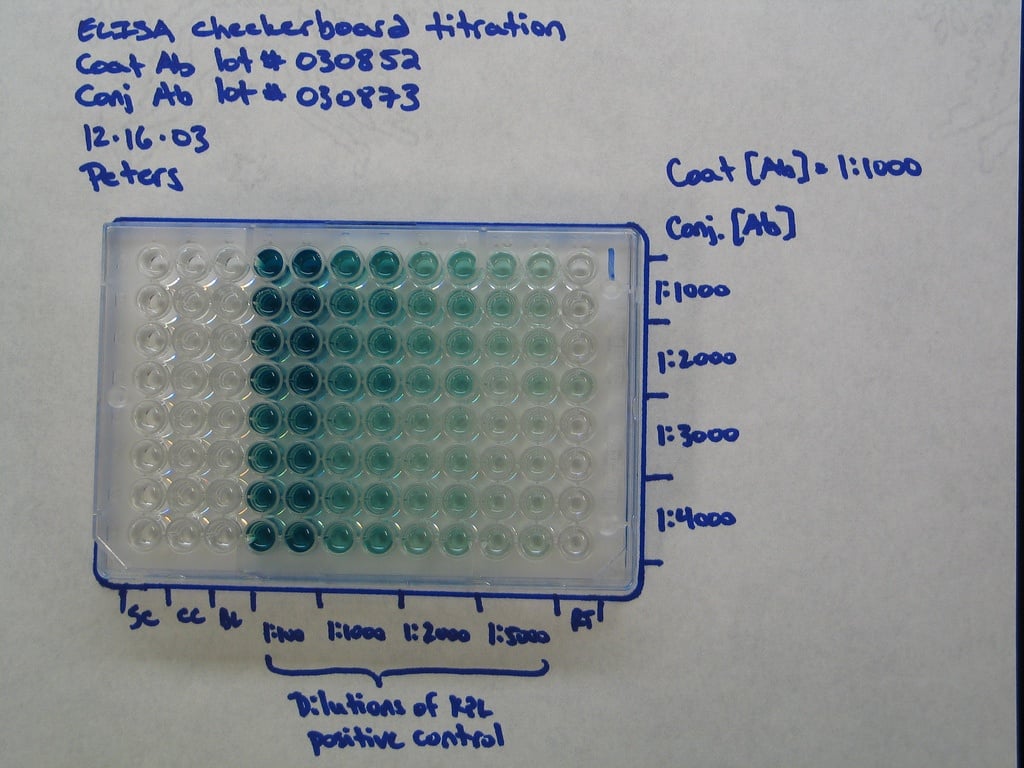In the previous article I introduced the principles of and differences between 4 types of ELISA.
How do you decide which type of ELISA to use?
The following list consists of questions that can guide you as you devise an ELISA experiment:
How specific should your ELISA to be?
Direct capture ELISA works like a Western blot by using a specially coated plate to capture the target antigen. While effective, there is a higher possibility of non-specific background signal, as many proteins in the heterogenous sample will bind to the coated plate.
Sandwich ELISA selectively captures and immobilizes the target antigen by binding an antibody to the plate that will specifically form a complex with your biomolecule under specific conditions. As a result, there will be less background signal. Many commercially available ELISA kits use indirect capture ELISA.
How sensitive should your ELISA be?
There are two major determinants for optimal sensitivity: the concentration of your target antigen in the total mixture and the antibody structure.
Conduct a literature search for the relative abundance of the target antigen in different cell lines. For example, Western blot analysis of the target antigen can give you a rough idea of how sensitive your ELISA must be in order to detect a signal.
Direct detection ELISA is less sensitive for the following reason: the immunoreactivity of the primary antibody is impaired because it is conjugated to the reporter enzyme. Indirect detection ELISA, on the other hand, is more sensitive because the primary antibody is not conjugated to the reporter enzyme. Rather, it is the secondary antibody that is conjugated with the reporter enzyme.
What is the desirable speed of processing?
Sandwich ELISA is slower because the use of two different antibodies requires more incubations and washes.
Are your pipettes calibrated?
For an assay as finicky as an ELISA, it’s imperative that your pipettes are accurate.
What are your controls?
There should be at least a “blank” (no addition of antibody and reporter enzyme), “non-specific binding” (addition of antibody and reporter enzyme to buffer only), and “positive controls” (known concentrations of target antigen).
Other general suggestions:
- Plan your plate layout! I would plan your cell culture plate layout and your assay plate layout ahead of time ON PAPER. With a tangible plate layout, you can take notes directly on it especially of any deviations you’ve made during the course of the assay.
- Store leftover reagents from a commercial ELISA kit as back-up.

Example Protocol for Indirect ELISA
I have had the most experience with a specific type of indirect capture-indirect detection competitive ELISA, and I'd like to share my protocol using cyclic AMP (cAMP) as the target antigen:
- Microplate wells are coated with antigen (Donkey anti-Rabbit Ig).
- On the antigen-coated well, unlabeled primary antibody (Rabbit anti-cAMP) is incubated in the presence of unlabeled antigen in the sample with unknown concentration of cAMP.
- Enzyme-linked antigen (cAMP-peroxidase) is added to the wells containing the antibody-sample antigen complexes, allowing the labeled antigen to bind to any unbound primary antibody. The less sample antigen, the more labeled antigen is retained in the well and the stronger the signal. In other words, there will be more of the primary antibody-labeled antigen that will bind to the antigen-coated wells.
- The plate is washed so that unbound antibodies are removed.
- A substrate (3,3’, 5,5’-Tetramethylbenzidine (TMB) substrate) is added to each well to react with the horseradish peroxidase to elicit a chromogenic signal.
- The reaction is stopped (with 1M Sulphuric Acid) to prevent eventual saturation of the signal.
This is a quantitative ELISA, so the optical density (OD) of the sample is compared to a standard curve, which is typically a serial dilution of a known concentration solution of the target molecule.
Here are my tips for reproducible quantification:
- In order to generate the best standard curve, I’d recommend running all samples in TRIPLICATE if you can.
- Collect OD readings multiple times post-addition of reporter enzyme to determine optimal reading time.
- You will have to determine empirically the optimal concentration of lysate that will generate an OD that is within the range of the standard curve. This will most likely entail diluting samples.
That's it!
I hope you found the ELISA tips here useful. Let me know in the comment section below if you have any question!
To help you find antibodies or kits for your next ELISA exerpiment, I'd suggest trying out BenchSci to review published data before making a decision, as a successful ELISA depends heavily on the specificity of the antibody used.

